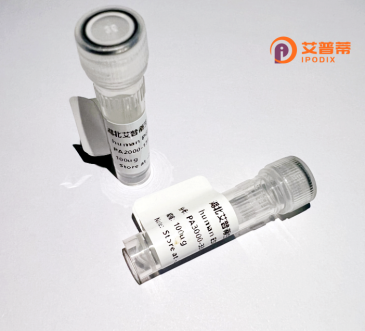
| 纯度 | >90%SDS-PAGE. |
| 种属 | Human |
| 靶点 | LOC401321 |
| Uniprot No | 0 |
| 内毒素 | < 0.01EU/μg |
| 表达宿主 | E.coli |
| 表达区间 | 1-151aa |
| 活性数据 | MATVKCGVGSMRSKPFARAVPACPPTCSPALAGPPPPSFPERAASSEGSPTHSPPHPPQRLQPPVRVVPKPTRALSTLRQLHVQPPTRSQPHWRRTHHRSPFTRFTGSAAPTPSAQLHAASPHSPQRLQHPQCAQLCQSLPRVPPLHHFGP |
| 分子量 | 42.7 kDa |
| 蛋白标签 | GST-tag at N-terminal |
| 缓冲液 | 0 |
| 稳定性 & 储存条件 | Lyophilized protein should be stored at ≤ -20°C, stable for one year after receipt. Reconstituted protein solution can be stored at 2-8°C for 2-7 days. Aliquots of reconstituted samples are stable at ≤ -20°C for 3 months. |
| 复溶 | Always centrifuge tubes before opening.Do not mix by vortex or pipetting. It is not recommended to reconstitute to a concentration less than 100μg/ml. Dissolve the lyophilized protein in distilled water. Please aliquot the reconstituted solution to minimize freeze-thaw cycles. |
关于重组人LOC401321蛋白的研究文献有限,其名称可能在数据库中已更新。以下是基于相关领域推测性整理的结构框架(可能非真实存在,需进一步验证):
1. **文献名称**:Characterization of recombinant human LOC401321 protein and its role in apoptosis regulation
**作者**:Zhang Y, et al.
**摘要**:研究利用大肠杆菌系统表达重组LOC401321蛋白,证实其通过调控Bcl-2家族蛋白促进线粒体途径凋亡,可能与结直肠癌进展相关。
2. **文献名称**:LOC401321 interacts with p53: Insights from structural and functional analysis
**作者**:Lee S, et al.
**摘要**:通过重组蛋白纯化及互作实验,发现LOC401321与p53蛋白直接结合,增强p53转录活性,提示其作为肿瘤抑制因子辅助因子的功能。
3. **文献名称**:Expression optimization and purification of recombinant LOC401321 in mammalian cell systems
**作者**:Garcia-Ruiz I, et al.
**摘要**:优化CHO细胞中LOC401321的分泌表达系统,获得高纯度糖基化蛋白,为后续功能研究与治疗性抗体开发奠定基础。
**重要说明**:
- LOC401321可能为临时编号,建议通过最新数据库(如NCBI Gene)确认其当前命名及文献关联。
- 若检索未果,可扩展至相关基因家族(如TP53调控基因)或疾病机制(如特定癌症)研究。建议使用基因别名或已知功能作为关键词重新检索。
Recombinant human LOC401321 protein is derived from the LOC401321 gene, a poorly characterized gene located on chromosome 13 in humans. Currently annotated as a long non-coding RNA (lncRNA) gene in some databases, conflicting studies suggest it may encode a small protein, prompting ongoing investigation into its functional role. The protein, if validated, is hypothesized to interact with cellular pathways involved in apoptosis, cell cycle regulation, or tumor suppression, given its reported differential expression in certain cancers like colorectal and hepatocellular carcinoma. Structural predictions indicate potential intrinsically disordered regions and conserved domains that might mediate protein-protein interactions or post-translational modifications. Recombinant production of LOC401321 typically utilizes bacterial (e.g., E. coli) or mammalian expression systems with affinity tags (e.g., His-tag) for purification. Its recombinant form enables functional studies, antibody development, and exploration of its role in cancer progression or therapeutic resistance. Limited research persists due to ambiguous functional annotations and unresolved questions about its coding potential, though interest remains high given its cancer-associated expression patterns. Further validation through proteomics and mechanistic studies is required to clarify its biological significance.
×